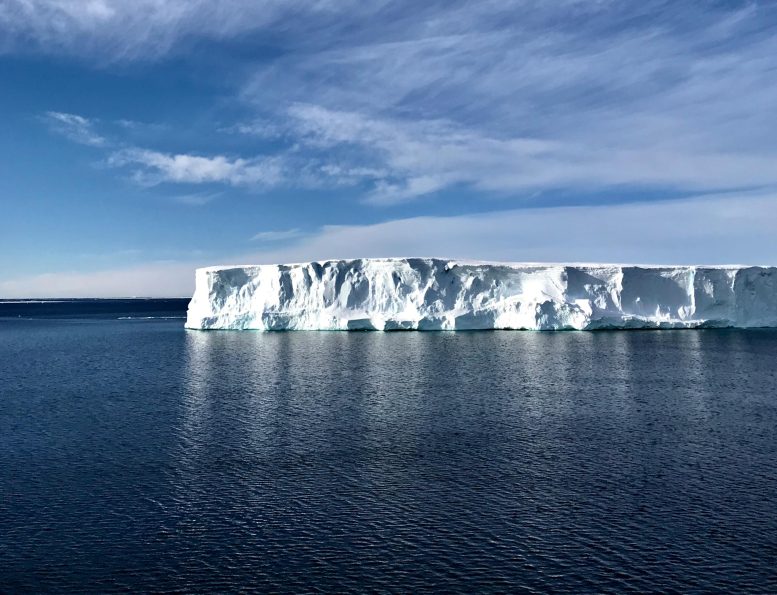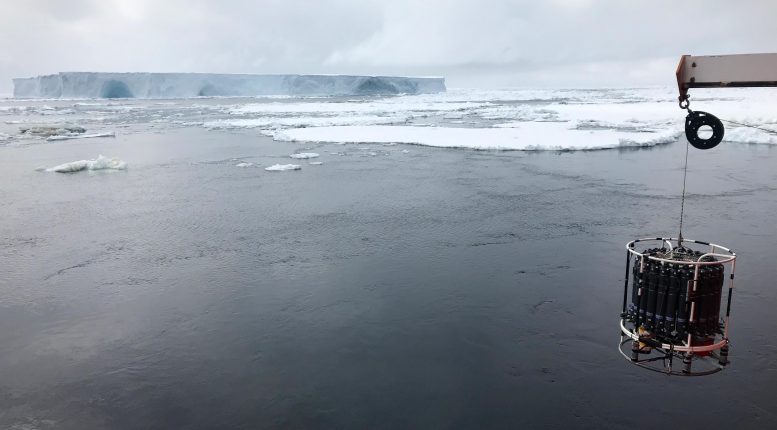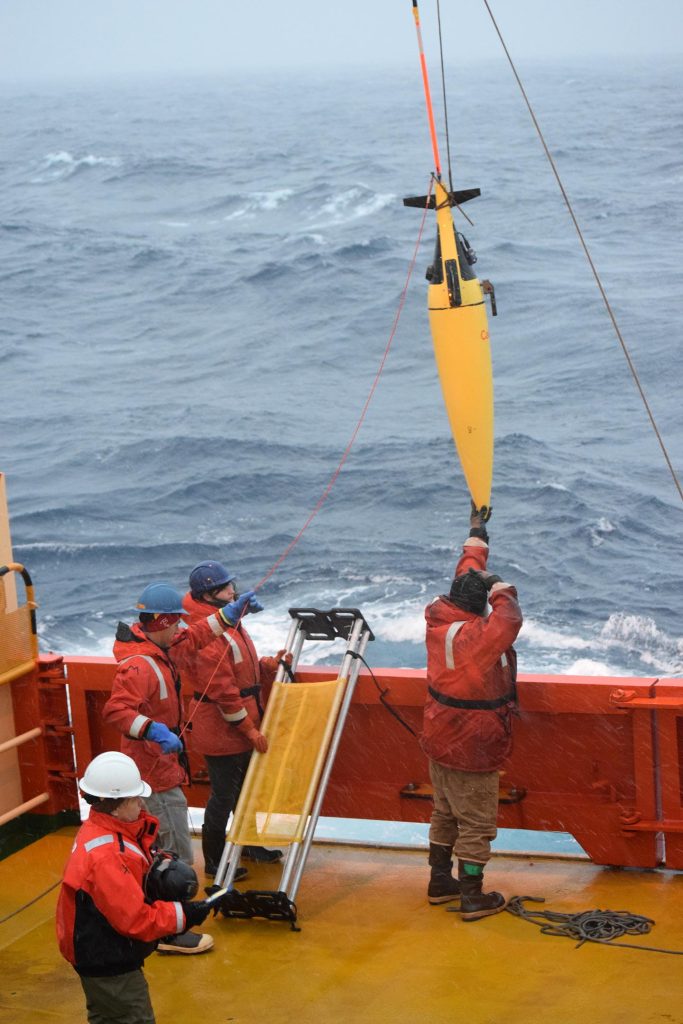
Sensor-Equipped Seals Uncover New Seawater Pathways Around Antarctica
-
by Anoop Singh
- 10

New research highlights how meltwater from Antarctic ice shelves, driven by climate change, affects neighboring ice shelves via ocean currents. This interconnected system, studied using innovative methods including sensor-equipped seals, is crucial for understanding and predicting sea level rise. Credit: Andy Thompson
Researchers have discovered that the meltwater from Antarctic ice shelves, exacerbated by climate change, is contributing to a complex network of ocean currents that influence ice melting across the continent.
Researchers at Caltech have used data from autonomous underwater vehicles and sensor-equipped seals to trace these meltwater pathways in the poorly studied Bellingshausen Sea. Their findings reveal new underwater features and currents that help predict future sea level rise by understanding these interconnected processes.
Impact of Climate Change on Antarctic Ice Shelves
Due to warming caused by climate change, the Antarctic ice shelves are melting at an accelerated rate. Most of the melt comes from below the ice shelves, a result of warm water flowing underneath them. However, the process does not stop there—as the meltwater enters the ocean, it is carried around the coast of Antarctica by ocean currents, modifying melt rates at ice shelves farther downstream. Mapping these meltwater pathways is needed to better understand and predict melting and resulting sea level rise.
“We used to think about ice shelves as isolated systems, but we now understand that multiple ice shelves are connected by currents along the Antarctic coast,” says Caltech’s Andy Thompson, John S. and Sherry Chen Professor of Environmental Science and Engineering. “What happens in one ice shelf changes the processes at another. To accurately predict changes, we have to understand the domino effect they have on one another.”

Measurements of temperature and salinity were collected from the R/V Nathaniel B. Palmer in the Bellingshausen Sea, Southern Ocean. The loss of volume of ice shelves in this region of West Antarctica has increased rapidly in recent decades. Credit: Andy Thompson
Discovering New Meltwater Pathways
For over a decade, researchers in Thompson’s laboratory have studied the Antarctic seas using a combination of techniques. A new study led by senior research scientist Mar Flexas examines data collected by an underwater autonomous vehicle as well as seals equipped with sensors on their heads. Through these data, the team discovered a new current that meltwater follows through a region known as the Bellingshausen Sea, on the side of Antarctica nearest to South America.
“The Bellingshausen Sea is not a well-studied region, but it’s the first place where warm water from the Atlantic and Pacific oceans reaches the ice shelves,” says Thompson, who is also the director of the Ronald and Maxine Linde Center for Global Environmental Science and executive officer for environmental science. “As it melts the ice shelves, the water becomes cooler and fresher, decreasing its capacity to melt.”

Deployment of an autonomous ocean vehicle, called a glider, in the Bellingshausen Sea, Southern Ocean. The gliders measure the temperature, salinity, and concentration of dissolved gases in the ocean. These can then be used to monitor how the ocean carries heat toward Antarctic floating ice shelves. Credit: Andy Thompson
Role of Seal Data in Climate Research
A decades-long collaboration of researchers from several institutions equips seals with small sensors that measure oceanic properties as the animals travel and dive through the seas in search of food. The program is called Marine Mammals Exploring the Oceans Pole to Pole (MEOP) and the data collected are publicly available to researchers.
Combining this data with that from the Thompson lab’s undersea ocean gliders, Flexas and her team collected information on properties like ocean temperature, salinity, oxygen content, and the concentration of particles in the water throughout the Bellingshausen and Amundsen seas.
Unveiling Subsea Currents and Troughs
The team identified two distinct meltwater pathways that originate from different ice shelves. One follows the coast and can increase melting at downstream ice shelves by trapping warm waters at depth, while the other path returns to the open ocean. Interestingly, the seal data revealed a previously unknown trough, or canyon, in the seafloor, which the team dubbed, appropriately enough, Seal Trough. Underwater topographic features like Seal Trough influence the flow of currents similarly to how canyons on dry land guide the flow of rivers.
Research Significance and Future Implications
The research is an important step toward understanding how melting at individual ice shelves influences the larger Antarctic circulation and ice shelf melting around the entire continent. As the oceans continue to warm due to climate change, an improved understanding of processes near the Antarctic coast is needed to predict future rates of global sea level rise.
The research is described in a paper titled “Pathways of Inter-Basin Exchange from the Bellingshausen Sea to the Amundsen Sea” and appears in the journal JGR Oceans.
Reference: “Pathways of Inter-Basin Exchange From the Bellingshausen Sea to the Amundsen Sea” by M. Mar Flexas, Andrew F. Thompson, Megan L. Robertson, Kevin Speer, Peter M. F. Sheehan and Karen J. Heywood, 02 June 2024, Journal of Geophysical Research: Oceans.
DOI: 10.1029/2023JC020080
In addition to Flexas and Thompson, Caltech undergraduate Megan Robertson is a co-author. Additional co-authors are Kevin Speer of Florida State University, and Peter Sheehan and Karen Heywood of University of East Anglia.
Funding was provided by the National Science Foundation, NASA, the Internal Research and Technology Development program at JPL-Caltech, and the European Research Council.
New research highlights how meltwater from Antarctic ice shelves, driven by climate change, affects neighboring ice shelves via ocean currents. This interconnected system, studied using innovative methods including sensor-equipped seals, is crucial for understanding and predicting sea level rise. Credit: Andy Thompson Researchers have discovered that the meltwater from Antarctic ice shelves, exacerbated by climate…
New research highlights how meltwater from Antarctic ice shelves, driven by climate change, affects neighboring ice shelves via ocean currents. This interconnected system, studied using innovative methods including sensor-equipped seals, is crucial for understanding and predicting sea level rise. Credit: Andy Thompson Researchers have discovered that the meltwater from Antarctic ice shelves, exacerbated by climate…
